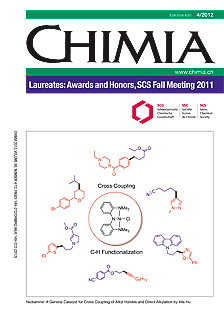Mass Spectrometric QUAL/QUAN Approaches for Drug Metabolism and Metabolomics
DOI:
https://doi.org/10.2533/chimia.2012.218Keywords:
Acetaminophen, High resolution, Mass spectrometry, Metabolomics, UhplcAbstract
A liquid chromatography–high-resolution mass spectrometry platform was used for simultaneous qualitative and quantitative (QUAL/QUAN) acquisition, enabling drug metabolism and metabolomics investi- gations. Plasma study samples were monitored for three different groups of patients at a single time-point (1 h after drug administration): one group received acetaminophen (APAP), one group received both APAP and ketorolac and one group was a control group. The quantification of APAP and two of its metabolites (APAP-glucuronide and APAP-cysteine) was performed on a fast acquisition quadrupole-Time-Of-Flight (50–100 ms duty cycle, resolving power of 30,000) compatible with UHPLC time constraints. High-resolution Selected Reaction Monitoring was used for quantification of APAP and its metabolites from 50–10,000 ng/mL using a 50 ?L plasma aliquot. Average measured concentrations were for APAP 6,650 ng/mL vs 6,160 ng/mL, APAP-CYS concentrations were 154.2 ng/mL vs 140.6 ng/mL and APAP-GLU concentrations 8,750 ng/mL vs 8,430 ng/mL between the group that received only APAP (n = 11) and the group that received APAP in combination with ketorolac (n = 11). No major differences were observed between the two groups of patients, as it would be expected due to the differing metabolism pathway for both substances. For the qualitative aspect, a metabolomics data processing platform with biological QC samples was applied to the study samples to search for unanticipated metabolites and biomarkers related to APAP and ketorolac metabolism. Multivariate analysis (i.e. Principle Component Analysis), variables grouping tools (i.e. PCVG) and high-resolution MS(/MS) spectra from the MSALL acquisition strategy enabled the profiling and characterization of circulating metabolites of APAP in plasma such as APAP-sulfate, APAP-mercapturate as well as ketorolac.Downloads
Published
2012-04-25
Issue
Section
Scientific Articles
License
Copyright (c) 2012 Swiss Chemical Society

This work is licensed under a Creative Commons Attribution-NonCommercial 4.0 International License.
How to Cite
[1]
D. Tonoli, E. Varesio, G. Hopfgartner, Chimia 2012, 66, 218, DOI: 10.2533/chimia.2012.218.







